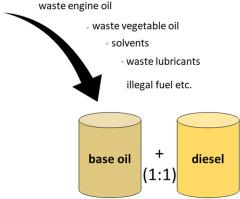Sustainable Chemistry and Pharmacy ( IF 5.5 ) Pub Date : 2020-05-12 , DOI: 10.1016/j.scp.2020.100266 Kadir Gedik , Burak Ak

|
This study deals with the combustion characteristics of base oil-based blends called number 10 lubes (NTLs), a blend of virgin/nonstandard base oils with low taxation petroleum products and/or wastes, used as diesel additive or substitute using thermogravimetric analysis with Fourier Transform Infrared Spectroscopy. Basic compositional analyses (i.e. elemental analysis, calorific value, sulfated ash) were also conducted with relevant methods in an accredited fuel analysis laboratory. In general, samples yielded exceptional characteristics in terms of sulfated ash content. Oxidation reactions were found to compose of one decomposition stage whilst up to three-stages were also observed outstandingly. Thermographs vary slightly in shape and position, similarly shaped to that for mineral oil, base oil or waste engine oil, and exhibited lower mass loss rates at low temperatures when compared to diesel. Quantitatively, combustion reactions occur between 236 ± 42.2 °C and 362 ± 39.0 °C yielding a maximum combustion rate and mass loss of 17.4 ± 3.87%/min and 98.4 ± 1.29%, respectively, on average, with major gases released carbon dioxide, water vapour, and the others complicating the interpretation of spectral bands. The combustion characteristic indices (ignition, flammability, burnout and comprehensive combustion index) also showed the combustion performance in favor of diesel > NTLs > mineral oil > waste engine oil > base oil > waste vegetable oil. Thus, this problem needs to be handled carefully via waste to fuel projects adopting the circular economy approach if sufficient knowledge on all of the technical and market aspects of such fuels would be obtained.
中文翻译:

柴油机中新鲜和废油混合物的特性和热性能
这项研究针对的是称为10号润滑油(NTLs)的基础油基混合物的燃烧特性,这是一种原始/非标准基础油与低税收石油产品和/或废物的混合物,用作柴油添加剂或使用傅里叶热重分析的替代品变换红外光谱。基本成分分析(即元素分析,热值,硫酸盐灰分)也通过相关方法在认可的燃料分析实验室中进行。通常,样品的硫酸盐灰分含量高。发现氧化反应由一个分解阶段组成,同时也突出地观察到多达三个阶段。热像仪的形状和位置略有不同,其形状类似于矿物油,基础油或废机油的形状,与柴油相比,在低温下的质量损失率更低。从数量上讲,燃烧反应发生在236±42.2°C和362±39.0°C之间,最大燃烧速率和质量损失分别平均为17.4±3.87%/ min和98.4±1.29%,主要气体释放出二氧化碳,水蒸气,其他使光谱带的解释复杂化。燃烧特性指标(点火,可燃性,燃尽和综合燃烧指标)也显示出燃烧性能,有利于柴油> NTL>矿物油>废发动机油>基础油>废植物油。从而,











































 京公网安备 11010802027423号
京公网安备 11010802027423号